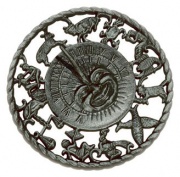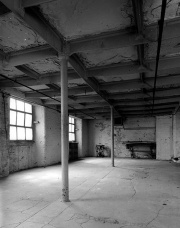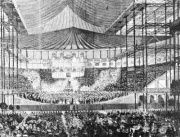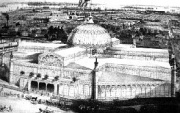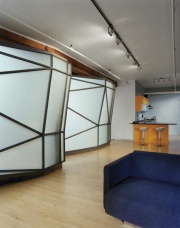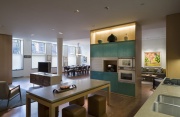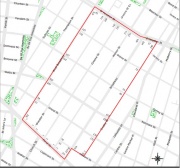Soho/Cast Iron
From The Peopling of NYC
A Brief Look into SOHO’s Cast Iron District
A Start in England
New York City’s Cast Iron District, most popularly known as SOHO, became a historic landmark by the New York City Landmarks Preservation Commission in 1973. SOHO is a historically and aesthetically vital piece of the city’s creation. Its 26-block radius is the embodiment of what is left of buildings with complete cast-iron facades. Although historically significant, SOHO is also a very prominent commercial neighborhood. Cast iron as a building material originated in England in the 1750s. By heating pig iron in coke or coal until it reaches its melting point and then using the molten mass to mold into any structure, the English found it a very useful and affordable type of edifice material.
Cast iron quickly became very trendy in Britain, eventually overtaking bronze as the most popular type of sculpture material.
1779 was marked by the building of a cast-iron bridge over the River Severn in England. By the end of the century a number of iron-framed buildings came up around the country.
Many textile mills were built out of cast iron by the end of the 18th century.
Using cast iron to support large glass greenhouses became extremely trendy as well. Most notably, in 1851, architect Joseph Paxton built the extraordinary London Crystal Palace Exhibition (shown above)
Cast-Iron Lands in America
Joseph Paxton’s design lent itself to the construction of another similar Crystal Palace Exhibition (For more information go to: [1] in New York City’s Bryant Park on 42nd street in 1854. This very similar edifice housed New York’s first world fair. Although the structure burnt down in 1858, its existence marked the beginning of extensive cast iron construction in New York City. New York City’s first major cast iron building, the Crystal Palace Exhibition in Bryant Park. This design was the backbone of the US Capital’s design in 1865.A Swamp Transforms Into a District
Until then end of the 18th century, SOHO was mostly a rural city with swamps and marshlands surrounding it. As it became more popular, the city filled in and drained out the quagmires and built the cast iron buildings. In 1848 James Bogardus actually built the first cast-iron building façade in today’s Tribeca in 1848. The method soon became prevalent as a swift and economical way of building elegant European-style buildings that imitated the more expensive stone buildings. Cast iron was also much more resistant to fire and lightning, and since fires were a huge concern for people in the 19th century, it was a major aspect of the desire for cast iron buildings. The transformation of SOHO attracted the middle class and the area soon became popular by middle class residents.
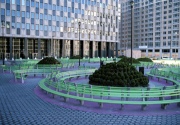
The Collect Pond was filled in to become the present Foley Square. Populating SoHo
By 1825, SOHO had the largest population in the city, including a big freed-slave population. Fashionable retail stores such as Lord and Taylor and Tiffany’s set themselves up against the newly erected luxury hotels. Music halls, theatres, and restaurants were built next. By 1850, Broadway (the western boundary of SOHO) replaced Bowery as the entertainment center of New York City. Although this entertainment center eventually moved towards 14th street, the ten years that it was there helped SOHO to expand and strengthen. SOHO assembled textile mills and factories from the cast iron architecture that was so popular in Europe at the time. SOHO is the center of some of the most elaborate and beautiful textile mills in the country.
A textile fortress built from cast-iron from the blueprints of the Renaissance Revival period. Many of the cast-iron facades built during this time were designed using French and Italian Renaissance architectural styles.
By the early 1900s the area once again changed and became a millinery (hat-making) manufacturing center. Hats, furs, and feathers for the middle class women were soon mass produced in factories around the district.
Onset of Artists and Construction of Their Studios
Originally built as light manufacturing spaces, warehouses, and department stores during the Industrial Revolution, many cast-iron lofts became artists’ studios in the 1960s. Artists were attracted to the bright light that the large windows allowed for and the large interior spaces built-in columns created. The rent was also very cheap. Many artists even moved in illegally because the areas they lived in were not equipped as residential locale. However, this was largely ignored until the 1970s and 1980s because the government knew that if the artists did not reside there than the area would probably be abandoned and economic conditions in SOHO would worsen.
Lofts with high ceilings and light filled rooms were perfect studios for artists who moved into SOHO’s cast-iron lofts. Artists’ presence turned SOHO into a type of renaissance, where different types of artists were able to draw together and create beautiful and unique pieces of artwork.

The artists brought with them galleries and boutiques. These drew tourists to come and visit.
SoHo Today
In the 1980s, real estate prices began to climb. Many artists, galleries, and stores fled to Chelsea, Long Island City, parts of Brooklyn, and Hoboken, NJ. In their place moved in middle-class families who could better afford the rent.
br>
19th century- Cast Iron appears in Soho
1840-1880- Cast Iron boom in SoHo
Cheaper than brick and stone
Can easily be repaired
Can be used to make patterns and designs
Strength allowed large windows and high ceilings
Believed to be fire resistant
1973- Twenty six blocks of Soho became a Historic District and landmark
quality retained exterior changes limited - changes must be appropriate to design - must be reviewed by The Landmarks Preservation Commission
RETURN TO SOHO HOME
